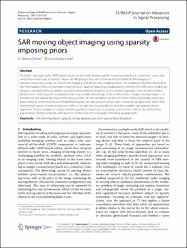SAR moving object imaging using sparsity imposing priors
Özet
Synthetic aperture radar (SAR) returns from a scene with motion can be viewed as data from a stationary scene, but with phase errors due to motion. Based on this perspective, we formulate the problem of SAR imaging of motion-containing scenes as one of joint imaging and phase error compensation. The proposed method is based on the minimization of a cost function which involves sparsity-imposing regularization terms on the reflectivity field to be imaged, considering that it admits a sparse representation as well as on the spatial structure of the motion-related phase errors, reflecting the assumption that only a small percentage of the entire scene contains moving objects. To incorporate the spatial structure of the phase errors into the problem, we provide three different sparsity-enforcing prior terms. In order to achieve computational gains, we also present a two-step version of our approach, which first determines regions of interest that are likely to contain the moving objects and then applies our sparsity-driven approach for joint image reconstruction and autofocusing in such a spatially constrained setting. Our preliminary experiments demonstrate the effectiveness of this new moving target SAR imaging approach.

















